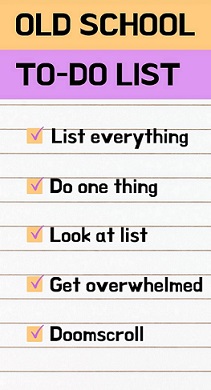Why To-do Lists Don't Work for You
When I hear the term 'to-do list', I think of a classic, single-column pile of tasks that are unsorted and unprioritized. These kinds of lists are serviceable at best and at worst can be defeatist, paralyzing, and a recipe for failure. They fail spectacularly when you struggle with decision fatigue, prioritization, or when you feel torn between tasks you really want to do and tasks you hate but feel like you OUGHT to do.
Why am I so passionate about to-do lists? The short answer is that I spent 40+ years with undiagnosed ADHD, struggling to figure out how to get myself organized and focused. Sometimes this was pretty easy. I'm an optimizer. Give me a pile of time and physical constraints, and I'll be massively productive. But if you gave me an 8-hour uninterrupted block of time, it often meant I would make a list; get overwhelmed, demotivated, and defeated; and then waste the entire day. It wasn't until I was diagnosed with ADHD that I began to understand why I get stuck in this cycle. It’s not a mark of failure, immaturity, or laziness. I just need some scaffolding to help ease the executive functioning load on my brain so I can succeed with less frustration.

My ADHD diagnosis also gave me insight into how emotional dysregulation can be at the root of struggling to get things started and finished. We need help managing our boredom, dread, disgust, sadness, and discomfort. And it’s not just people with ADHD who need this support. Anxiety, depression, grief, burnout, huge life changes, and the ongoing struggle of coping in a global pandemic can all impact our ability to process our emotions which, in turn, impacts our motivation and ability to focus.
In my own struggle, I initially felt that there must be One True Answer. One perfect format that suited me. I found plenty, but they never worked for very long. But of course, they weren’t The Answer for several reasons, primarily because my mental needs fluctuate, so I’m simply not going to settle into a rhythm that always works. Life, circumstances, and internal and external stressors change, so it absolutely makes sense that a one-size fits all solution just isn’t realistic.
This series is about finding the right structure for your day’s energy, focus, and level of executive functioning as they fluctuate based on your stress level, sleep quality, anxiety, outside disturbances, and much more. I’ll present not just how each format works, but also WHY it works. At the end of the series, I’ll conclude with a handy guide so that you can easily match your struggle with the right kinds of scaffolding.
I’ll kick things off next post with a quick overview of why your motivation gets hijacked and some other foundational issues you may have encountered in the wild.
If you're interested in reading the rest of the series, sign up for my newsletter, or follow me on Facebook or Twitter